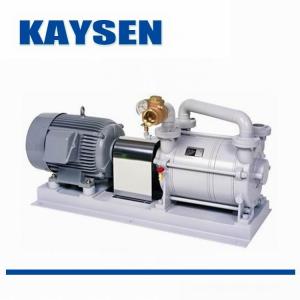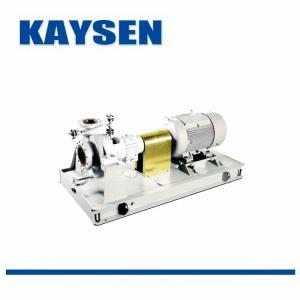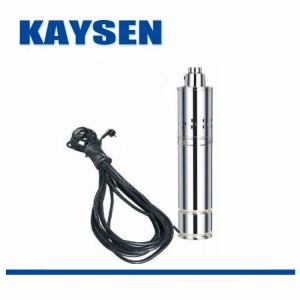
|
- 品牌:德国KAYSEN
- 发布日期: 2019-06-26
- 更新日期: 2025-12-28
| 品牌 | 德国KAYSEN |
| 连接形式 | 法兰 |
| 材质 | 铸铁、不锈钢、铝合金、氟塑料 |
| 型号 | KAYSEN |
| 工作压差 | 0 |
| 适用范围 | 水、污水、石油、化工、电子、饮料、食品 |
| 压力环境 | 常压 |
| 介质温度 | 1200℃ |
| 驱动方式 | 电动 |
| 适用介质 | 蒸汽 |
柱塞式计量泵|原装品质计量泵
凯森(KAYSEN)品牌,*的十*。
凯森始终坚持“重质量,讲信誉”为宗旨。产品现畅销全国各地,并已逐步开发海外市场。公司多次被评为“重合同讲信用”企业,深得用户的信赖和广泛的赞誉。
KAYSEN凯森柱塞隔膜计量泵概述
无阀式运行柱塞计量泵常规系列带有旋转控制柱塞,这种泵的运行是通过柱塞往复移动和旋转运动完成的。
这样,柱塞本身就可以打开和关闭吸入和输出口,而不需要阀,这种泵的冲程频率工作范围广。
基于这种原理,常规泵可以计量高粘度甚至含有大颗粒杂质的液体。
泵头材质是不锈钢的,柱塞及其腔体都是由一种特殊涂层来保护的。
根据应用场合的不同,泵头还可以采用更好的材质制造。
在柱塞和腔体之间的间隙,主要是用来填充密封件,以用来计量高粘度液体。
泵头背面的小天窗用橡胶环形密封件来密封,计量泵内液体流动的方向通过柱塞的安装方式来选择。围绕水平轴来转动泵头,从而达到重复吸入液体。
主要特点:
可输送两种不同介质
可电控或摇控
流量可从百分之零到*动态调节
双柱塞设计,脉冲小,工作平稳
*流量15500升/时,*压力64兆帕
主要优点:
在泵运行或停止状态均可调节流量
安装空间小
多种材质及泵类结构可选
稳定精度±2%(调节比10%-100%)
坚固耐用,维护成本低
机械驱动PTFE膜片(多种隔膜材质)
主要应用:
化工
石油化工
冶金
电力
医药
食品
塑料发泡

基本的预防性维护保持泵流动
执行预防性维护有助于防止泵停机
有人说:“你不知道自己得到了什么,直到它消失。”对于任何曾经忽视泵的人来说,这个概念可能是太熟悉了。可靠的泵在正常工作时并不真正被认可,但是如果泵的性能下降,或者更糟糕的是,该设备完全停止工作,那么可靠性会被错过。为避免泵停机和随后的麻烦,必须遵守预防性维护计划。
每天开始泵检查。最重要的日常检查之一是发动机油的质量和水平。肮脏的油可能会导致严重的问题并降低发动机的使用寿命; 同样,如果数量不足。根据制造商的建议更换机油或根据需要添加以达到水平。
检查汽油水平,确保油箱已满,或者至少满足一天的使用量。同时寻找任何燃油或漏油迹象。如果液体滴落,请检查该区域是否有可能需要拧紧或更换的部件。
清洁或可能更换空气过滤器是另一个可以防止重大损坏的重要做法。堵塞,潮湿或肮脏的空气过滤器会导致动力损失,并通过允许污垢或水进入敏感区域来缩短发动机的使用寿命。泡沫元件可以清洁和重复使用,所以每天检查一下就可以了。如果过滤器已损坏或缺少大块,请将其更换。对于纸质空气过滤器,操作员应按照推荐的时间表及时更换。
定期检查软管的状况。如果它们磨损,磨损或有任何漏洞,则气隙可能会导致泵失去吸力。修补任何孔并密封泄漏的接头。应该更换严重磨损的软管。*,检查机器的其余部分是否有螺栓,螺母或零件松动。
在所有的手术前检查中,日常维护中最重要的事情可能就是在开始之前启动泵。运行干燥的泵会损坏密封件,导致更多问题的连锁反应。如果是自吸泵,只需加水即可。术语“自吸”有点用词不当,因为每次使用时必须将水添加到泵中。然后泵将接管,在蜗壳内建立压力并开始排放。
不太频繁的检查
一旦泵已经准备好了,就可以开始工作了。除日常检查外,泵还需要其他维护检查和服务。虽然这些不需要每天完成,但它们对泵的使用寿命至关重要,并应定期按计划进行。一般来说,优质的泵引擎可以运行几千小时,并且遵循推荐的维护计划只能增加该时间和泵的投资回报率。
有几件事情需要每月检查几次,其他事件则更少。例如,纸张空气过滤器应在需要时更换。虽然泡沫过滤器可以清洗并重新使用,但是当它开始分解或分解时,需要更换。
脏的火花塞可能会导致功率下降和起动性能差,因此应每半月检查一次火花塞是否有残留油污,污垢,损坏或积碳过多的情况。用钢丝刷或火花塞清洁器清洁火花塞。立即更换任何火花塞与裂纹瓷。
每年都要对泵进行彻底检查,检查是否有肮脏,破损或未对齐的部件。这些部件可能会导致发动机或泵部件出现问题。检查整台机器可以*地了解需要清洁和修理的部件。
值得注意的是,灰尘状况通常会缩短正常服务之间的时间长度,因为*的灰尘会堵塞过滤器元件或污染燃料和机油。取决于泵的环境,可能需要调整维护计划以适应低于*条件。
故障排除提示
即使定期进行适当的预防性维护计划,泵仍然可能会遇到问题。这很不幸,但很常见。知道如何寻找并快速解决问题将使问题不再成为更昂贵,耗时的修复。
如果泵不启动,罪魁祸首可能是叶轮或发动机。如果叶轮粘住,只需拆下泵盖,清洁并重新安装。至于引擎,几个不同的东西可能会影响它,并阻止从开始。
首先要检查的是火花塞。如果它被油渣,气体或碳污染,请清洁它。如果它损坏了,请更换它。如果它干净无损,请将其连接到插头盖并将插头与发动机机身接地。拉起动器,看看火花是否微弱或不存在。如果新的或清洁的插头没有点燃,则点火系统可能有故障,可能需要更换。
如果火花塞松动或插头浸湿燃油,发动机也可能无法启动。如果火花塞是潮湿的,请检查燃油旋塞是否关闭。如果是这样,关闭阻风门拉杆并拉动起动手柄6次,看电极是否变湿。如果电极干燥,问题可能与化油器的燃料吸入有关。试着看看燃油停在发动机的哪里。
其他一些事情可能会导致泵不能自行灌注。首先检查泵吸入侧的漏气情况; 如果需要,拧紧吸入软管或管道。检查排水塞,确保它完全拧紧。泵壳内的水不足也会阻止泵启动。
发动机转速也会影响泵送量。如果泵送量下降,则抽吸软管可能太长或抽吸腔室上的零件松动可能需要重新拧紧。这也可能是由于需要降低高吸力,水通道漏水,机械密封磨损或断裂或发动机输出功率或速度下降造成的。
采取积极主动的预防措施,确保关键的维护服务不会被忽视,防止泵出现故障时产生多米诺骨牌效应,浪费时间并增加维修成本。这很简单直接 - 泵的维护现在意味着更少的问题。遵循良好的维护计划,例如上述步骤,是保持泵流量的*和*的方法之一。
Basic Preventive Maintenance to Keep Pumps Flowing
Performing preventive maintenance helps prevent pump downtime
It has been said, “You don’t know what you’ve got until it’s gone.” This concept can be all-too-familiar for anyone who has ever neglected a pump. A dependable pump isn’t truly appreciated when it’s working properly but that dependability is really missed if a pump’s performance declines, or worse, the unit stops working altogether. To avoid pump downtime and subsequent headaches, a preventive maintenance program must be followed.
Start each day with a pump inspection. Among the most important daily checks is the quality and level of engine oil. Oil that’s dirty can cause serious problems and decrease the life of an engine; likewise, if there’s an insufficient amount of it. Change the oil or add if necessary to reach the level as per manufacturer recommendation.
Check the gasoline level as well, making sure the tank is full, or at least full enough for the day’s usage. Also look for any evidence of fuel or oil leaks. If a fluid is dripping, inspect the area for any parts that may need to be tightened or replaced.
Cleaning or possibly changing the air filter is another important practice that can prevent significant damage. A clogged, wet or dirty air filter can lead to a loss in power and shorten the life of an engine by allowing dirt or water into sensitive areas. A foam element can be cleaned and reused, so it’s fine to check daily. If the filter has been damaged or is missing chunks, replace it. For paper air filters, operators should follow a recommended schedule for replacement in a timely fashion.
Inspect the condition of the hoses regularly, as well. If they are worn, frayed or have any holes, the air gaps will likely cause the pump to lose suction. Patch any holes and seal leaking joints. A severely worn hose should be replaced. Finally, check the rest of the machine for broken bolts, nuts or loose parts.
Of all the pre-operation checks, perhaps the most important thing to remember for daily maintenance is priming the pump before starting. Running a pump dry will damage the seals, causing a chain reaction of further problems. If it’s a self-priming pump, simply add water. The term “self-priming” is somewhat of a misnomer, as water must be added to the pump each time it is used. The pump will then take over, build pressure within the volute and begin discharging.
Less-frequent Checks
Once the pump has been prepped, it’s ready to go to work. In addition to daily checks, a pump requires other maintenance checks and services. While those don’t need to be done daily, they are crucial to the pump’s life and should be kept up with on a regular schedule. Generally, quality pump engines can operate for a few thousand hours, and following recommended maintenance schedules can only increase that time and the pump’s ROI.
A few things need to be checked a couple of times a month, others even less frequently. For instance, a paper air filter should be changed when needed. Although a foam filter can be cleaned and re-used, when it begins to disintegrate or come apart, replacement is necessary.
Dirty spark plugs can cause a decrease in power and poor starting performance, so the spark plugs should be checked semi-monthly for oil residue, dirt, damage or excessive carbon buildup. Clean spark plugs with a wire brush or spark plug cleaner. Immediately replace any spark plugs with cracked porcelain.
On an annual basis, give the pump a thorough inspection for dirty, broken or misaligned parts. Such parts can cause problems with the engine or pump components. Inspecting the entire machine gives the most comprehensive view of what needs to be cleaned and repaired.
It’s also worth noting that dusty conditions typically shorten the length of time between regular services, as extreme dust can clog filter elements or contaminate fuel and oil. Depending on the pump’s environment, maintenance schedules may need to be adjusted to accommodate for less than optimal conditions.
Tips For Troubleshooting
Even with a regular, proper preventive maintenance program, pumps may still experience problems. This is unfortunate, but common. Knowing what to look for and addressing it quickly will keep the problem from becoming a more expensive, time-intensive repair.
If a pump won’t start, the culprit is likely the impeller or engine. If the impeller is sticking, simply disassemble it by taking the pump cover off, clean and reinstall. As for the engine, several different things could affect it and prevent if from starting.
The first thing to check is the spark plug. If it’s dirty with oil residue, gas or carbon, clean it. If it’s damaged, replace it. If it’s clean and damage-free, connect it to the plug cap and ground the plug against the engine body. Pull the starter to see if the spark is weak or nonexistent. If a new or cleaned plug doesn’t spark, the ignition system could be faulty and may need replacement.
The engine also might not start if the spark plug is loose or if the plug is wet with fuel. If the spark plug is wet, check to see that the fuel cock is closed. If so, close the choke lever and pull the starter handle a half-dozen times to see if the electrode becomes wet. If the electrode is dry, the problem may be with the fuel intake of the carburetor. Try to see where the fuel stops in the engine.
A number of other things could cause a pump to not self-prime. Start by checking for air leaks on the suction side of the pump; tighten the suction hose or pipe, if needed. Check the drain plug, as well, to ensure that it has been tightened completely. Insufficient water inside the pump casing will also prevent the pump from priming.
Engine speed can affect pumping volume, as well. If the pumping volume has dropped, the suction hose may be too long or loose parts on the suction chamber may need re-tightening. This might also be caused by a high suction lift that would need to be lowered, water leaking from the water passage, a worn or broken mechanical seal or a drop in engine output or speed.
Adopting a proactive preventive approach ensures that crucial maintenance services won’t be neglected, preventing a domino effect of problems as the pump goes down, time is lost and repair costs add up. It’s simple and straightforward - pump maintenance now will mean fewer issues later. Following a good maintenance program, such as the steps detailed above, is among the best and most inexpensive ways to keep a pump flowing.
柱塞式计量泵|原装品质计量泵








